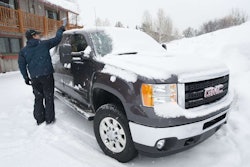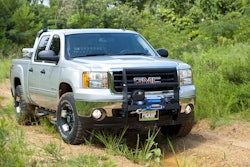Tire pressure monitoring systems
 If you are one of those who tow, haul heavy loads or switch tires seasonally, aftermarket TPMS systems are a must
If you are one of those who tow, haul heavy loads or switch tires seasonally, aftermarket TPMS systems are a must
Since 2008, the Great Oz in Washington has decreed that all passenger cars and light-duty trucks be equipped with tire pressure monitoring systems (TPMS). It’s not a bad idea since the average driver rarely checks vehicle tire pressures, and this will probably keep more than a few of them from hurling tire chunks at the rest of us.
But the OEM TPMS function more or less as idiot lights; they tell you when a tire drops more than 25 percent of its recommended pressure, but nothing more.
With the right aftermarket system, however, you can often get:
• Actual pressure numbers in psi – not just low pressure warnings – for each tire.
• Multiple sensors to track the pressure on your trailer as well as your vehicle tires.
• Programmable interfaces that allow you to switch tires and sensor positions and change parameters when you need to air up or lower the pressure in a tire or tires.
• Tire temperature warnings or actual tire temperatures.
 Many aftermarket sensors simply screw onto your valve stems and transmit to a display on your dash.
Many aftermarket sensors simply screw onto your valve stems and transmit to a display on your dash.
There are two basic types of TPMS in the aftermarket arena: internal sensors that mount on the interior rim of the wheel, and external sensors that screw into your valve stem. Both are powered by batteries and send a radio signal to a receiver that you put in the cab.
Of the valve stem models there are those with replaceable batteries and those that are permanently sealed. The sealed units are disposed when the batteries die.
Replaceable batteries will save you some money here, but the argument is that having a battery compartment that you can open and close is a potential leak point. Replaceable, sealed units will cost you about $50 to $60 a tire and last three years.
There are more than a dozen different TPMS aftermarket systems available. The folks who pull campers and big recreational vehicles have been using TPMS for years. So have car gadget freaks, tuners and obsessive Teutonic types who just have to know what their psi readings are have plenty of automotive systems to choose from as well.
Variety is good, but you have to be very careful and sort through your choices to find a system that is specifically geared toward contractor trucks and trailering systems. Read the literature carefully and call the company if you have questions.
Those in the construction trade should look for a TPMS system that is:
• Portable – you can put it on new tires or seasonal tires when you switch them out.
• Programmable – to adopt to the highest pressure your tires will allow.
• Powerful – batteries should have enough juice to send the signal from the back tires of your long bed truck or your trailer to a receiver in your cab (most automotive systems have fairly weak signals).
A system with a “sleep mode” is also nice: the system goes to sleep on command or after a period of inactivity, thus saving on battery life.
So are TPMS systems that will link up to truck telematics systems for more sophisticated tracking and monitoring remotely.
Prices run from about $150 for the low cost four-wheel systems to $400-plus for more sophisticated systems.
TIRE REPAIR & TPMS
TPMS sensors are not easy to break. However, care must be taken when changing tires  because they can get damaged in the process, costing $50 to $100 for a replacement. So always ask your tire dealer if they’re trained and equipped to service that specific OEM TPMS. Most should be.
because they can get damaged in the process, costing $50 to $100 for a replacement. So always ask your tire dealer if they’re trained and equipped to service that specific OEM TPMS. Most should be.
If your maintenance shop does tire work, then it’d be good to invest in a one of the special tools used to diagnose, clear and reprogram a TPMS. Companies such as OTC, Bartec and ATEQ offer them with prices starting around $600.
If you’re going to rely on your OEM TPMS system and you switch off to snow or mud tires when the weather changes, you’ll need to get the sensors swapped into the extra set of rims. Or, get a compatible set of OEM sensors at the dealer, at reputable tire vendors, or through Internet sources.







